Towards the Realization of Graphene Based Flexible Radio Frequency Receiver
Abstract
:1. Introduction
2. Flexible Graphene RF Transistor Fabrication
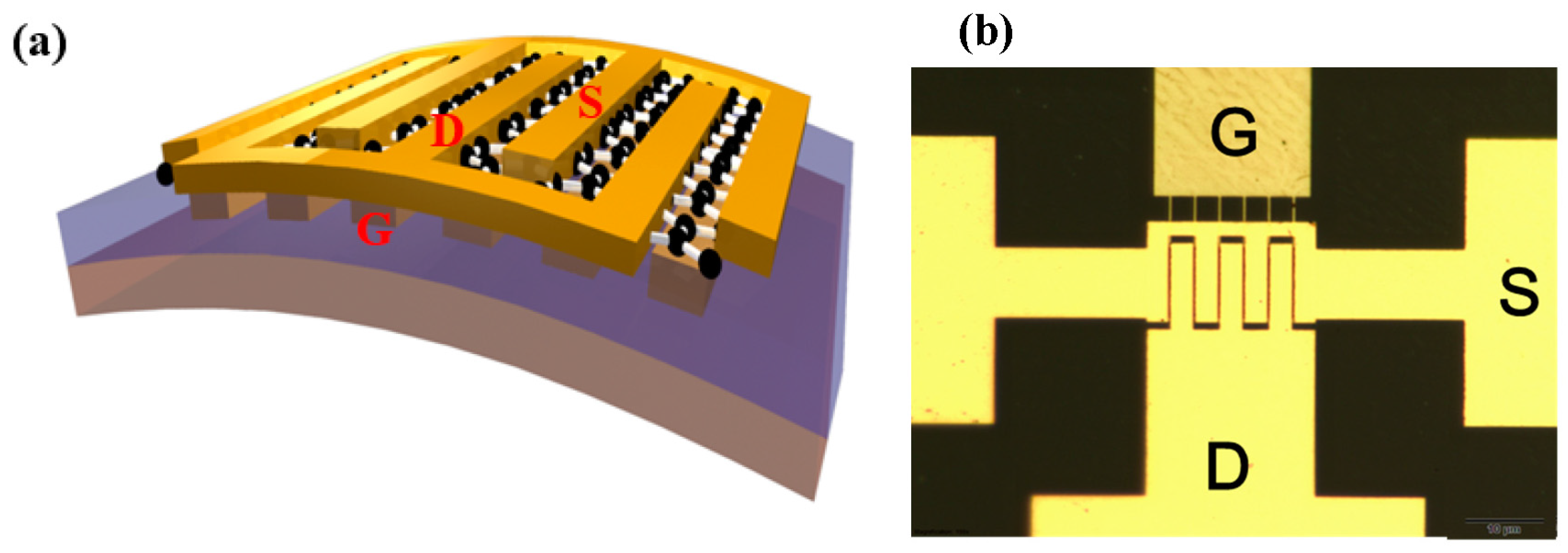
3. Results and Discussion
3.1. Compact Model of GFET
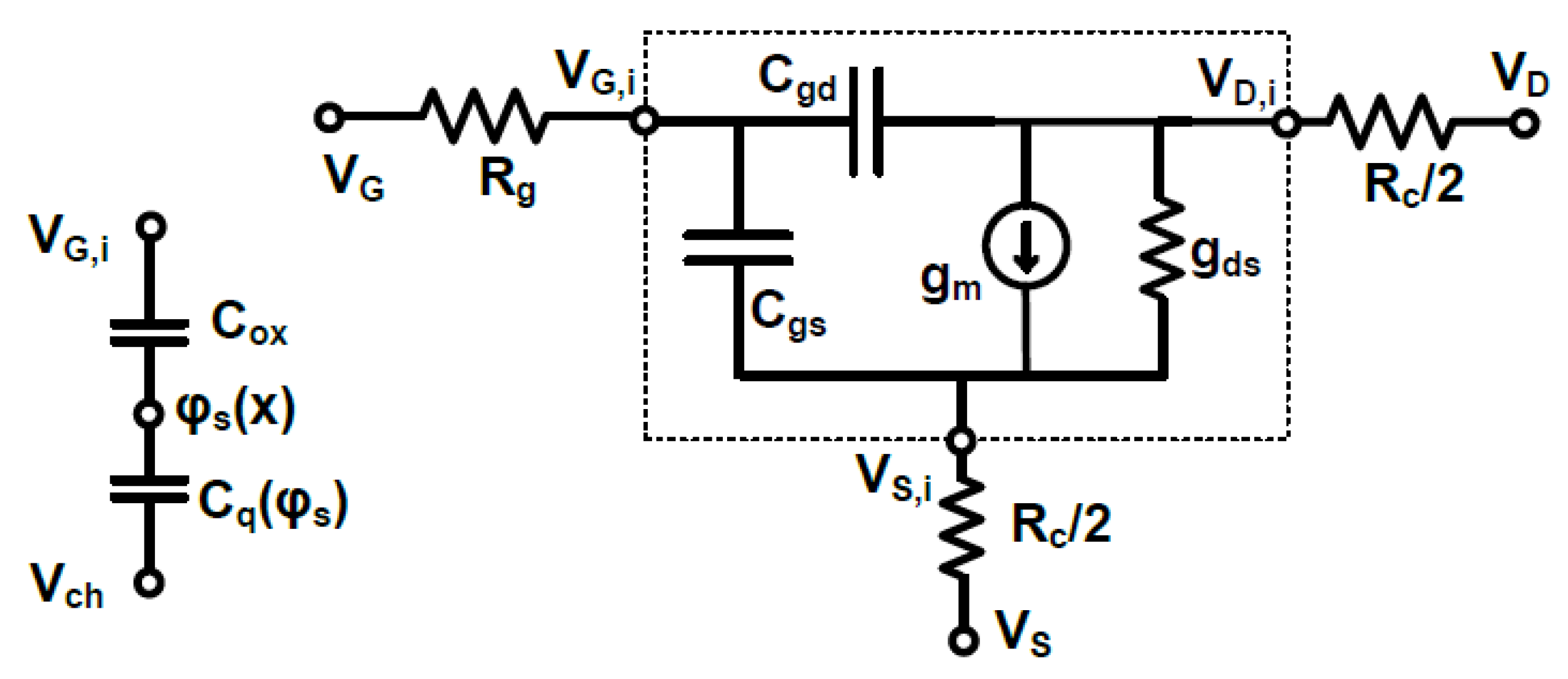
3.2. GFET DC Measurement
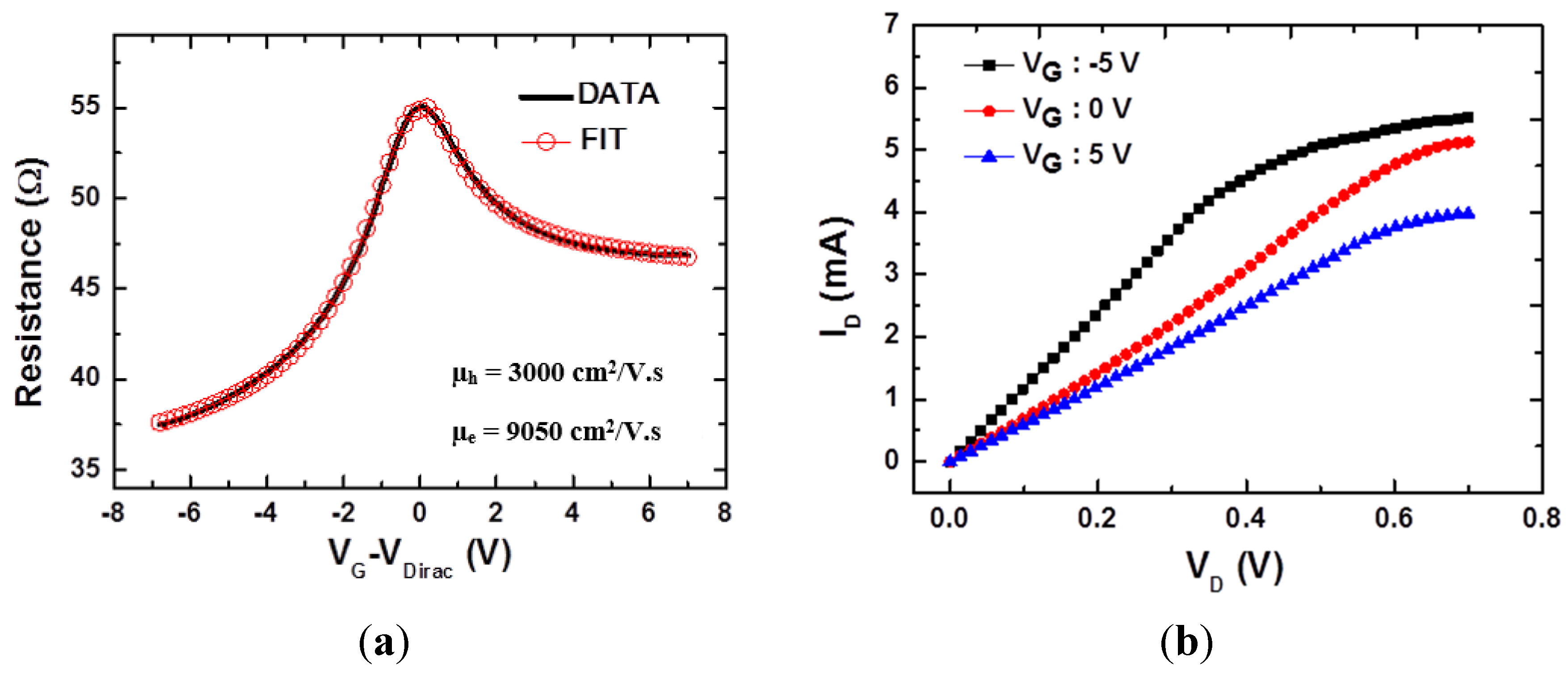
3.3. GFET RF Measurement

3.4. GFET Flexibility and Reliability
3.5. GFET Based Flexible Receiver
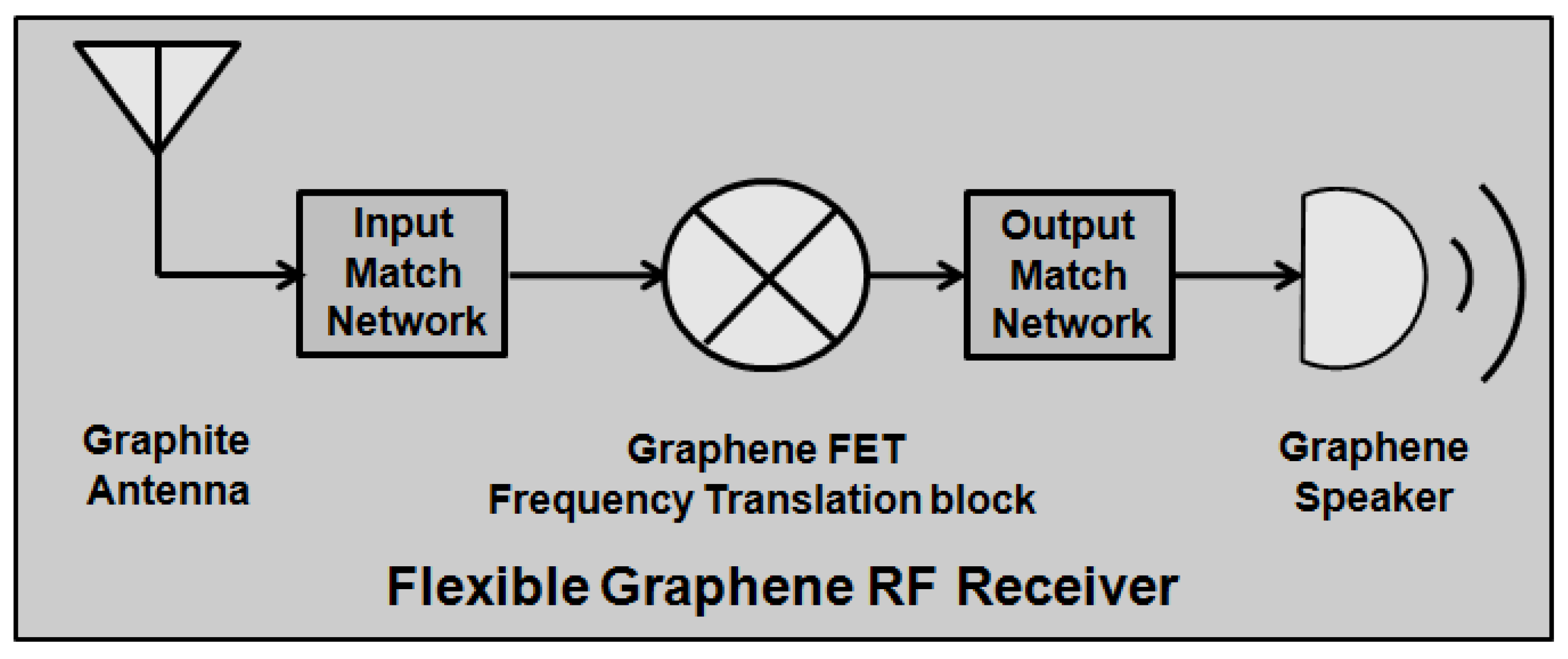
3.5.1. Graphite Flexible Antenna


3.5.2. Frequency Translation Block
(1) GFET Doubler
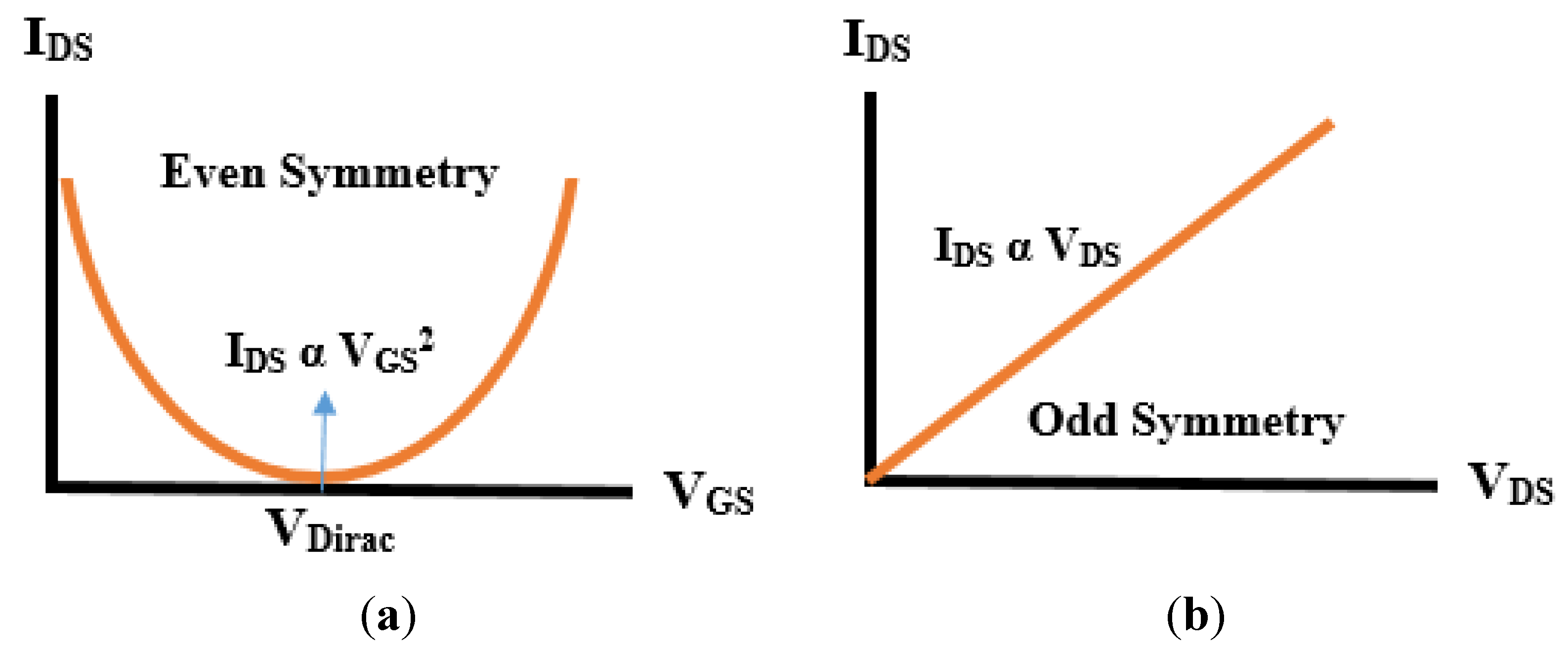
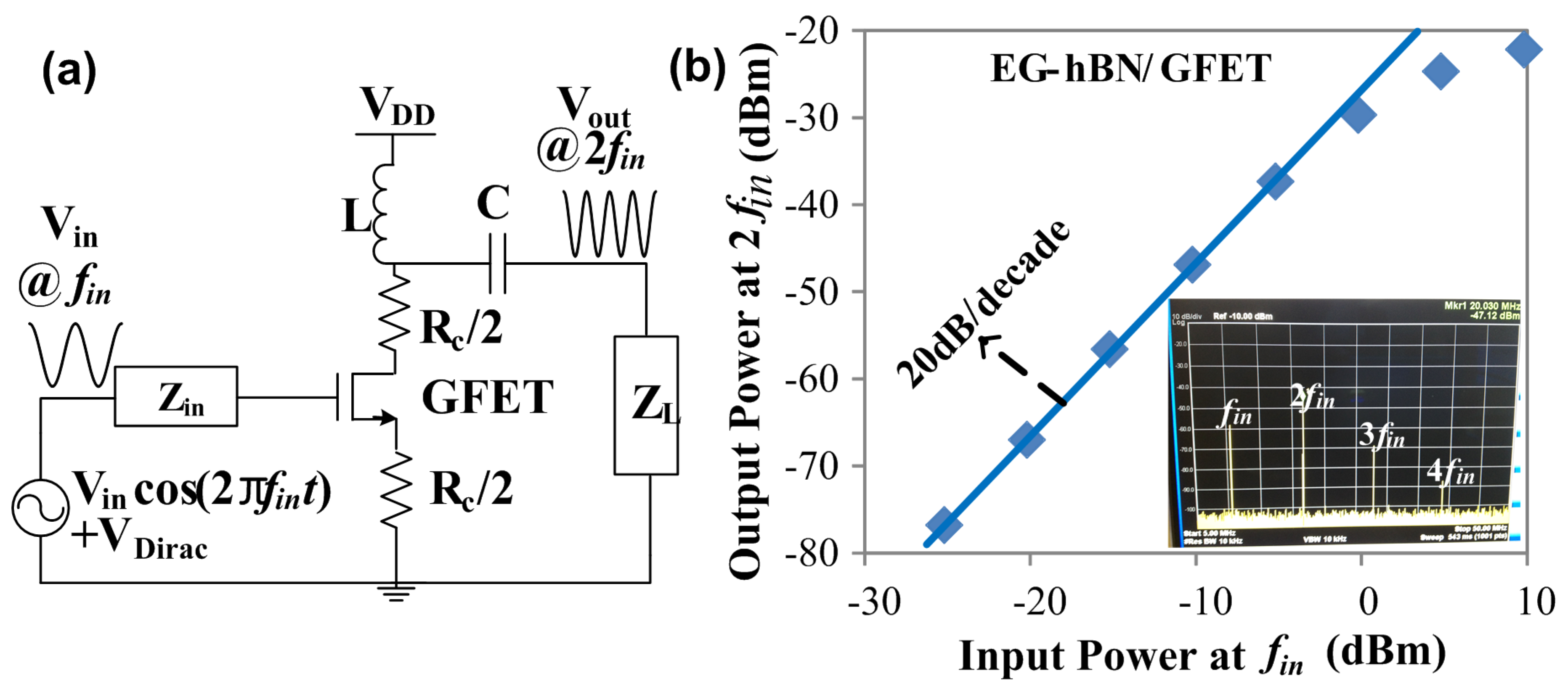
(2) GFET AM Demodulator
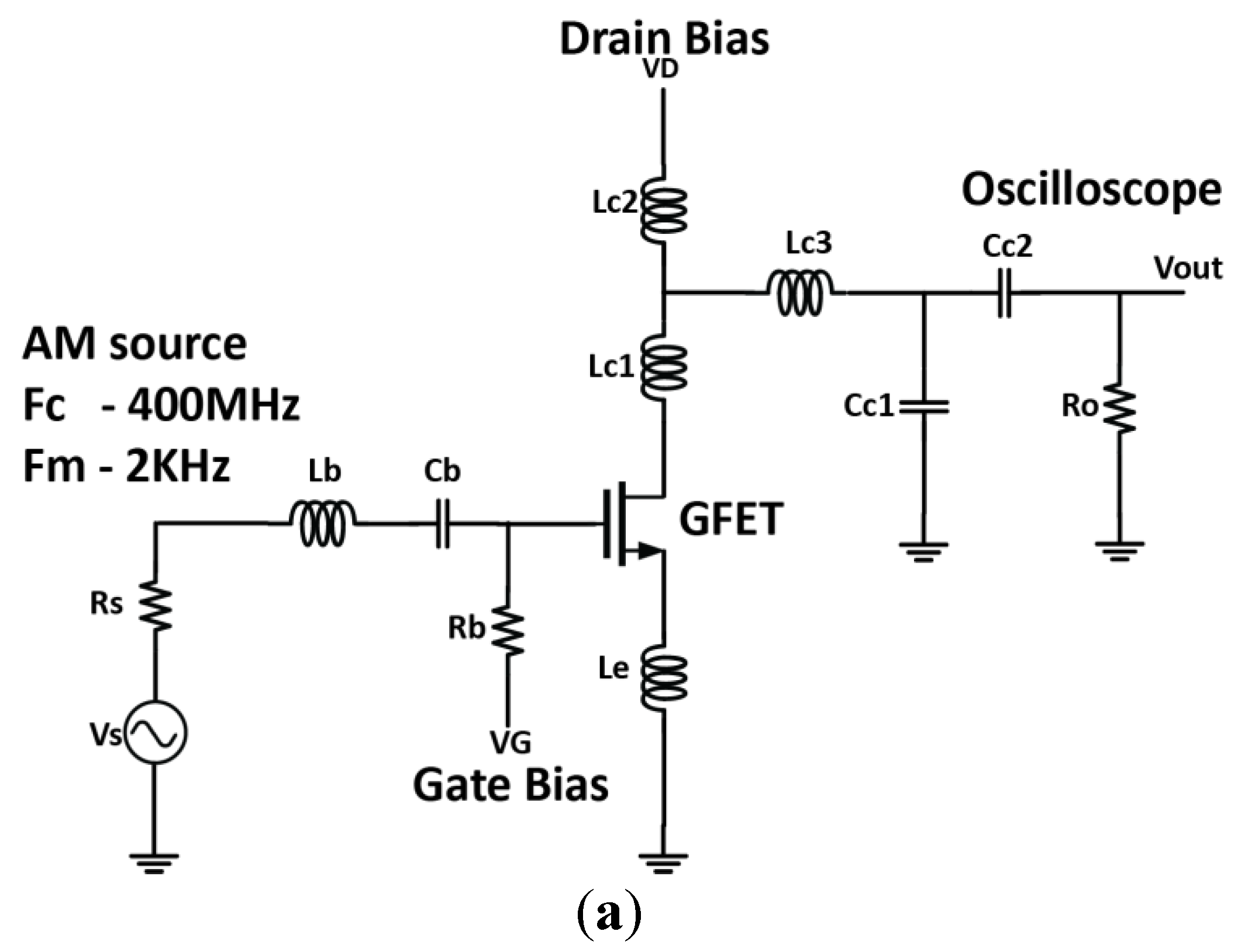

3.5.3. Flexible Graphene Speaker

3.5.4. Graphene AM Radio Receiver

4. Conclusions
Acknowledgments
Author Contributions
Conflicts of Interest
References
- Russer, P.; Fitchner, N. Nanoelectronoics in Radio Frequency technology. IEEE Microw. Mag. 2010, 11, 119–135. [Google Scholar] [CrossRef]
- Akinwande, D.; Petrone, N.; Hone, J. Two-dimensional flexible nanoelectronics. Nat. Commun. 2014, 5. [Google Scholar] [CrossRef] [PubMed]
- Schwierz, F. Graphene Transistors: Status, Prospects, and Problems. Proc. IEEE 2013, 101, 1567–1584. [Google Scholar] [CrossRef]
- Akinwande, D.; Tao, L.; Yu, Q.; Lou, X.; Peng, P.; Kuzum, D. Large-Area Graphene Electrodes: Using CVD to facilitate applications in commercial touchscreens, flexible nanoelectronics, and neural interfaces. Nanotechnol. Mag. IEEE 2015, 9, 6–14. [Google Scholar] [CrossRef]
- Yeh, C.-H.; Lain, Y.-W.; Chiu, Y.-C.; Liao, C.-H.; Moyano, D.R.; Hsu, S.S.H.; Chiu, P.-W. Gigahertz Flexible Graphene Transistors for Microwave Integrated Circuits. ACS Nano 2014, 8, 7663–7670. [Google Scholar] [CrossRef] [PubMed]
- Nathan, A.; Ahnood, A.; Cole, M.T.; Sungsik, L.; Suzuki, Y.; Hiralal, P.; Bonaccorso, F.; Hasan, T.; Garcia-Gancedo, L.; Dyadyusha, A.; et al. Flexible Electronics: The Next Ubiquitous Platform. Proc. IEEE 2012, 100, 1486–1517. [Google Scholar] [CrossRef]
- Kim, D.H.; Lu, N.; Ma, R.; Kim, Y.S.; Kim, R.-H.; Wang, S.; Wu, J.; Won, S.M.; Tao, H.; Islam, A.; et al. Epidermal Electronics. Science 2011, 333, 838–843. [Google Scholar] [CrossRef] [PubMed]
- Lee, J.; Ha, T.; Li, H.; Parrish, K.N.; Holt, M.; Dodabalapur, A.; Ruoff, R.S.; Akinwande, D. 25 GHz Embedded-Gate Graphene Transistors with High-K Dielectrics on Extremely Flexible Plastic Sheets. ACS Nano 2012, 7. [Google Scholar] [CrossRef] [PubMed]
- Chang, H.; Yang, S.; Lee, J.; Tao, L.; Hwang, W.; Jena, D.; Lu, N.; Akinwande, D. High-Performance, Highly Bendable MoS2 Transistors with High-K Dielectrics for Flexible Low-Power Systems. ACS Nano 2013, 7, 5446–5452. [Google Scholar] [CrossRef] [PubMed]
- Li, X.; Cai, W.; An, J.; Kim, S.; Nah, J.; Yang, D.; Piner, R.; Velamakanni, A.; Jung, I.; Tutuc, E.; et al. Large-area synthesis of high-quality and uniform graphene films on copper foils. Science 2009, 324, 1312–1314. [Google Scholar] [CrossRef] [PubMed]
- Wang, H.; Hsu, A.L.; Palacios, T. Graphene electronics for RF applications. Microw. Mag. IEEE 2012, 13, 114–125. [Google Scholar] [CrossRef]
- Han, S.; Garcia, A.V.; Oida, S.; Jenkins, K.A.; Haensch, W. Graphene radio receiver integrated circuit. Nat. Commun. 2014, 5. [Google Scholar] [CrossRef] [PubMed]
- Lee, S.; Lee, K.; Liu, C.; Kulkarni, G.S.; Zhong, Z. Flexible and transparent all-graphene circuits for digital quaternary modulations. Nat. Commun. 2012, 3. [Google Scholar] [CrossRef] [PubMed]
- Park, S.; Zhu, W.; Chang, H.-Y.; Yogeesh, M.N.; Ghosh, R.; Banerjee, S.; Akinwande, D. High-frequency prospects of 2D nanomaterials for flexible nanoelectronics from baseband to sub-THz devices. In Proceedings of the 2015 IEEE International Electron Devices Meeting (IEDM) Technical Digest, Washington, DC, USA, 7–9 December 2015; pp. 32.1.1–32.1.4.
- Parrish, K.N.; Ramón, M.E.; Banerjee, S.K.; Akinwande, D. A Compact Model for Graphene FETs for Linear and Non-linear Circuits. In Proceedings of the SISPAD 2012, Denver, CO, USA, 5–7 September 2012.
- Lee, J.; Ha, T.J.; Parrish, K.N.; Chowdhury, SF.; Tao, L.; Dodabalapur, A.; Akinwande, D. High performance current saturating graphene field-effect transistor with hexagonal boron nitride dielectric on flexible polymeric substrates. IEEE Electron Device Lett. 2013, 34, 172–174. [Google Scholar] [CrossRef]
- Parish, K. Nanoscale Graphene for RF Circuits and System. Ph.D. Dissertation, University of Texas at Austin, Austin, TX, USA, August 2013. [Google Scholar]
- Koolen, M.C.A.M.; Geelen, J.A.M.; Versleijen, M.P.J.G. An Improved De-Embedding Technique for on-Wafer High-Frequency Characterization. In Proceedings of the IEEE 1991 Bipolar Circuits and Tech Meeting, Minneapolis, MN, USA, 9–10 September 1991.
- Lee, J. Graphene Field Effect Transistors for Flexible High Frequency Electronics. Ph.D. Dissertation, University of Texas at Austin, Austin, TX, USA, May 2013. [Google Scholar]
- Panasonic PGS Graphite Sheets. Available online: http://industrial.panasonic.com/lecs/www-data/pdf/AYA0000/AYA0000CE2.pdf (accessed on 30 June 2014 ).
- Ferendeci, A.; Devlin, C.L.H. Microwave Charecterization of Graphite and Intercalated Graphite as an Antenna Element. In Proceedings of the 2012 IEEE National Aerospace and Electronics Conference (NAECON), Dayton, OH, USA, 25–27 July 2012.
- Parrish, K.N.; Akinwande, D. Even-odd symmetry and the conversion efficiency of ideal and practical graphene transistor frequency multipliers. Appl. Phys. Lett. 2011, 99, 223512. [Google Scholar] [CrossRef]
- Tian, H.; Ren, T.; Xie, D.; Wang, Y.; Zhou, C.; Feng, T.; Fu, D.; Yang, Y.; Peng, P.; Wang, L.; et al. Graphene-on-Paper sound source devices. ACS Nano 2011, 5, 4878–4885. [Google Scholar] [CrossRef] [PubMed]
- Suk, J.W.; Kirk, K.; Hao, Y.; Hall, N.A.; Ruoff, R.S. Thermoacoustic sound generation from monolayer graphene for transparent and flexible sound sources. Adv. Mater. 2012, 24, 6342–6347. [Google Scholar] [CrossRef] [PubMed]
- Yogeesh, M.N.; Parrish, K.N.; Lee, J.; Tao, L.; Akinwande, D. Towards the design and fabrication of graphene based flexible GHz radio receiver systems. In Proceedings of the 2014 IEEE MTT-S International Microwave Symposium (IMS), Tampa, FL, USA, 1–6 June 2014.
© 2015 by the authors; licensee MDPI, Basel, Switzerland. This article is an open access article distributed under the terms and conditions of the Creative Commons Attribution license (http://creativecommons.org/licenses/by/4.0/).
Share and Cite
Yogeesh, M.N.; Parrish, K.N.; Lee, J.; Park, S.; Tao, L.; Akinwande, D. Towards the Realization of Graphene Based Flexible Radio Frequency Receiver. Electronics 2015, 4, 933-946. https://doi.org/10.3390/electronics4040933
Yogeesh MN, Parrish KN, Lee J, Park S, Tao L, Akinwande D. Towards the Realization of Graphene Based Flexible Radio Frequency Receiver. Electronics. 2015; 4(4):933-946. https://doi.org/10.3390/electronics4040933
Chicago/Turabian StyleYogeesh, Maruthi N., Kristen N. Parrish, Jongho Lee, Saungeun Park, Li Tao, and Deji Akinwande. 2015. "Towards the Realization of Graphene Based Flexible Radio Frequency Receiver" Electronics 4, no. 4: 933-946. https://doi.org/10.3390/electronics4040933




